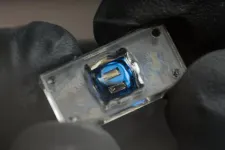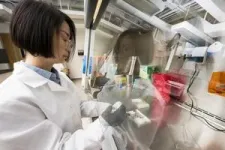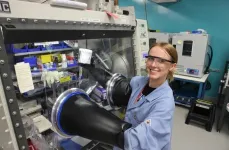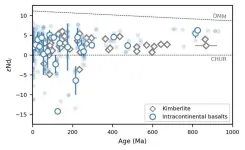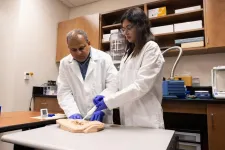(Press-News.org) Scientists are developing advanced tools to understand and treat neurological symptoms such as brain fog associated with respiratory diseases like influenza. The Biomedical Advanced Research and Development Authority (BARDA), part of the Administration for Strategic Preparedness and Response (ASPR) within the US Department of Health and Human Services (HHS), awarded a three-year contract to researchers at the University of Rochester to develop a technology to model respiratory disease effects on the brain and test therapeutic drugs to prevent and treat symptoms. The base-year is funded at $2.4 million with two option years which, if fully funded, would total $7.1 million.
The project will use microphysiological systems (MPS)— small chips with ultrathin membranes supporting 3D networks of human cells, also known as “tissue chips”—to simulate infection and treatment in vitro. This tissue chips will incorporate human lung and brain tissue models.
“This is another step toward making disease modeling and drug discovery focused from the very beginning on more complex, human-relevant systems,” says principal investigator Benjamin Miller, a Dean’s Professor of Dermatology at Rochester with joint appointments in biomedical engineering, biochemistry and biophysics, optics, and materials science. “These chips can help make the whole drug discovery process faster.”
The project builds on work at Rochester’s recently established Translational Center for Barrier Microphysiological Systems (TraCe-bMPS) to build FDA-qualified drug development tools for studying the body’s barrier functions in combating disease. The center was created earlier this year with a $7.5 million grant from the National Institutes of Health.
Co-investigator James McGrath, the William R. Kenan Jr. Professor of Biomedical Engineering and director of TraCe-bMPS, has been using microphysiological systems to study the mechanism by which inflammatory factors can enter the brain through the circulation and cause injury. The new BARDA-funded project will link two of McGrath’s modular, mass-producible chips specialized to mimic different organs.
“This project will connect this ‘brain’ chip upstream of a second chip that models a common source of those injurious factors: the infected lung,” says McGrath. “I’m thrilled to be working with a highly interdisciplinary Rochester team and with BARDA to develop what will be a scientifically important new tool.”
As with Long COVID, common viruses such as influenza can produce chronic symptoms such as brain fog, fatigue, and enduring pain. The project offers a new way to explore the relationship between the lungs and brain.
“The respiratory tract, with its cellular, humoral and hard-wired conduits to the brain, stands as the first line of defense against emerging infectious threats from zoonotic spillovers,” says co-investigator Harris "Handy" Gelbard, director of the Center for Neurotherapeutics Discovery at the University of Rochester Medical Center. “We and our collaborators, with the support of the National Institute on Aging, have worked for the past several years to investigate these mechanisms in the hopes of applying therapeutic agents to ameliorate neurologic disease, especially in the elderly that are vulnerable to these infections. Now, with a world-class team of in-house experts at developing labs-on-a-chip, we have the unique opportunity to fast-track our research in a new lung-to-brain chip.”
David Dean, professor of pediatrics, biomedical engineering, and pharmacology and physiology, has studied the disease processes that lead to acute respiratory distress syndrome (ARDS) in the hopes of developing new treatments for this devastating disease.
“Studying this required us to use cultured cells from the lung, but almost always, these are grown and studied by themselves, which is not anywhere close to the situation in the lung where over 40 different cell types co-exist and interact to allow us to live. Thus, this is way too simplistic of a model,” says Dean, co-investigator of the project. “On the other extreme, we have used animal models to test hypotheses and drugs in development, but these models are so hard to control and make sense of because so many different things are going on, and it is difficult to attribute a response to a single pathway, leading to a system that is almost too complicated.”
He says the new approach is a win-win solution that will allow the researchers to mimic complex interactions between key cell types in the lung but in a controlled manner.
David Topham, the Marie Curran Wilson and Joseph Chamberlain Wilson Professor of microbiology and immunology and director of the Translational Immunology and Infectious Diseases Institute will also serve as a co-investigator and Hani Awad, the Donald and Mary Clark Distinguished Professor in Orthopaedics and a professor of biomedical engineering, will act as a consultant. The team will be working with University of Rochester spinout companies Phlotonics to do medium-throughput instrumentation and SIMPore to develop the chips.
The project will last three years, and by the end of the first year, the team aims to link the tissue chip systems with immune cells, demonstrate that they can infect the lung chip with influenza, and observe an inflammatory response in the brain chip. This project has been supported in whole or in part with federal funds from the Department of Health and Human Services; Administration for Strategic Preparedness and Response; Biomedical Advanced Research and Development Authority (BARDA), under contract number 75A50124C00040.
Elected officials voice support for innovative technology development
US Senator Charles Schumer: “I am thrilled to see our researchers leading the charge in groundbreaking medical innovation with this substantial $7.1 million award from the Department of Health and Human Services. This investment speaks volumes about the world-class research happening right here in Rochester. By developing microchips that mimic brain and lung tissue, our scientists are pioneering new ways to understand and combat respiratory diseases and their impact on the brain. This cutting-edge research has the potential to revolutionize our approach to treating these diseases, paving the way for more effective therapies and ultimately saving lives. I remain committed to advocating for robust federal support for scientific advancements that can change the future of healthcare and improve public health outcomes for all.”
US Senator Kirsten Gillibrand: “Researchers at the University of Rochester are leading the charge in disease modeling and drug discovery. This $7.1 million contract from HHS will help researchers at the University of Rochester develop the most advanced technology to model respiratory disease effects and find ways to prevent and treat symptoms. I will continue to fight to secure federal resources to support the innovative work of researchers at the University of Rochester.”
Congressman Joe Morelle: “The University of Rochester continues to drive groundbreaking research, innovation, and scientific advancement in the world of medicine. This significant federal award is further proof of their leadership and limitless potential. I congratulate their team of researchers on their outstanding achievements that will change the way we fight diseases.”
END
Scientists developing microchips with brain and lung tissue to study viral neuroinflammation
Researchers will use tissue-on-chip technology as a new way to explore the relationship between the lungs and brain.
2024-10-16
ELSE PRESS RELEASES FROM THIS DATE:
Discover science: Applications open for summer 2025 undergraduate internships
2024-10-16
WASHINGTON, DC – As the nation continues to build a diverse, clean-energy workforce, the Department of Energy (DOE) today announced that applications are being accepted for the Summer 2025 term of two undergraduate internship programs.
The Office of Science Undergraduate Laboratory Internships (SULI) program and the Community College Internships (CCI) program are unique opportunities open to all current and recent college undergraduates. Interns will learn about science and technology careers, team science, networking, and gain the experience needed to transition from internship to employment.
The application deadline for both programs is January 8, 2025, ...
Can electricity treat high blood pressure?
2024-10-16
UNIVERSITY PARK, Pa. — Several medications are available to treat high blood pressure, but more than 10 million Americans do not respond to the treatments, according to the American Heart Association. Using a bioelectronic device to deliver pulsed electricity to the body has proven to be a promising strategy to treat drug-resistant hypertension patients, according to Penn State researcher Tao Zhou, although he noted that its practical application in patient care has significant limitations.
Zhou, assistant professor of engineering science and mechanics and of biomedical engineering, received ...
Microplastics detected in dolphin breath
2024-10-16
U.S. researchers have detected microplastic particles in air exhaled by wild bottlenose dolphins, suggesting that inhalation may be a relevant route of exposure to these potentially harmful contaminants. Miranda Dziobak of the College of Charleston in South Carolina, U.S., and colleagues present these findings in the open-access journal PLOS ONE on October 16, 2024.
Around the world, humans and numerous other animals are exposed to tiny particles of plastic contaminants known as microplastics. In humans and rodents, microplastic exposure has been linked to adverse health impacts, such as oxidative stress and inflammation. Ingestion ...
Global north’s growing appetite for farmed salmon imperils communities’ access to local fish
2024-10-16
A new paper published today in Science Advances exposes the global aquaculture sector’s growing dependence on wild fish. Despite industry claims to the contrary, these findings highlight how the growing appetite for expensive farmed salmon can leave coastal communities struggling to access affordable local fish like sardines and anchovies. Instead, these small pelagic fish are frequently caught, processed, and “reduced” to fishmeal and fish oil, almost all of which is used to feed farmed fish. These ‘reduction fisheries’ account for 26% of global ocean catch.
“As the aquaculture industry grows, so does its ...
e-Flower records neuronal activity with electronic petals
2024-10-16
Neural spheroids — 3D clusters of brain cells — are emerging as essential tools for understanding neural networks and studying neurological diseases in the lab. EPFL’s e-Flower, a flower-shaped 3D microelectrode array (MEA), allows researchers to monitor the electrical activity of these spheroids in a way that was previously impossible. This breakthrough, published in Science Advances, lays the groundwork for more sophisticated research on brain organoids, which are complex, miniaturized models of brain tissues.
“The ...
Aquaculture uses far more wild fish than previously estimated, study finds
2024-10-16
A study published in the journal Science Advances suggests that global fish farming, or aquaculture, may rely on significantly larger quantities of wild-caught ocean fish than previously calculated. The study is part of a special issue focused on expanding contributions from the aquaculture industry to food systems with an aim towards sustainability.
These findings call into question long-held assumptions about the sustainability of the rapidly growing aquaculture industry and provides a range of plausible estimates for its impact on wild fish populations.
The research, led by an international team of scientists ...
Gene editing approach paves the way to first-in-human clinical trial for rare genetic disease
2024-10-16
A collaborative effort between investigators at the National Institutes of Health’s National Institute of Allergy and Infectious Diseases (NIAID) and Massachusetts General Hospital (MGH), a founding member of the Mass General Brigham healthcare system, demonstrates the potential of precise genome editing technologies, called adenine base editors, to correct disease-causing mutations in stem cells from patients with X-linked chronic granulomatous disease (X-CGD), a rare genetic disorder characterized by high susceptibility to infections. The findings are published in Science Translational Medicine.
Patients with ...
Compositional evolution of the upper mantle driven by plate tectonics
2024-10-16
On present-day Earth, plate subduction continuously modifies the chemical composition of the convecting mantle, and various mantle sources linked to these processes have been widely studied.
However, when did global chemical heterogeneity of the convecting mantle first emerge in Earth's geological history? And how might Earth’s geodynamic evolution have influenced the chemical composition of the convecting mantle over time?
Researchers from the Institute of Oceanology of the Chinese Academy of Sciences (IOCAS), along with collaborators from Australia, Switzerland and the USA, have tried to address these questions ...
Virtual reality game used to help students in science classes
2024-10-16
Multilingual students face unique challenges that can hurt their performance in school. New methods of teaching may help close this gap, according to a new study from the University of Georgia.
In the United States, English is the main language used in classrooms. Schools also tend to rely on spoken communication to teach and written exams to assess learning.
That can make it difficult for multilingual students to express themselves. This is especially true in science classes, with their specific terms and complex sentence structures.
So a UGA researcher developed an immersive virtual reality game to communicate scientific ...
Life-saving spongelike “bandage” developed by UCF researchers rapidly stops hemorrhaging and mitigates risk of infection
2024-10-16
Video available here.
Without proper medical invention, injuries sustained from traffic collisions, serious workplace accidents or weapons may result in fatal hemorrhaging.
University of Central Florida researchers aim to prevent such bleeding in potentially deadly situations with a new hemostatic spongelike bandage with antimicrobial efficacy that they recently developed and detailed in a newly published study in the journal Biomaterials Science.
“What happens in the field or during an accident is due to heavy bleeding, patients can die,” says Kausik Mukhopadhyay, assistant professor of materials ...
LAST 30 PRESS RELEASES:
Tracing the quick synthesis of an industrially important catalyst
New software sheds light on cancer’s hidden genetic networks
UT Health San Antonio awarded $3 million in CPRIT grants to bolster cancer research and prevention efforts in South Texas
Third symposium spotlights global challenge of new contaminants in China’s fight against pollution
From straw to soil harmony: International team reveals how biochar supercharges carbon-smart farming
Myeloma: How AI is redrawing the map of cancer care
Manhattan E. Charurat, Ph.D., MHS invested as the Homer and Martha Gudelsky Distinguished Professor in Medicine at the University of Maryland School of Medicine
Insilico Medicine’s Pharma.AI Q4 Winter Launch Recap: Revolutionizing drug discovery with cutting-edge AI innovations, accelerating the path to pharmaceutical superintelligence
Nanoplastics have diet-dependent impacts on digestive system health
Brain neuron death occurs throughout life and increases with age, a natural human protein drug may halt neuron death in Alzheimer’s disease
SPIE and CLP announce the recipients of the 2025 Advanced Photonics Young Innovator Award
Lessons from the Caldor Fire’s Christmas Valley ‘Miracle’
Ant societies rose by trading individual protection for collective power
Research reveals how ancient viral DNA shapes early embryonic development
A molecular gatekeeper that controls protein synthesis
New ‘cloaking device’ concept to shield sensitive tech from magnetic fields
Researchers show impact of mountain building and climate change on alpine biodiversity
Study models the transition from Neanderthals to modern humans in Europe
University of Phoenix College of Doctoral Studies releases white paper on AI-driven skilling to reduce burnout and restore worker autonomy
AIs fail at the game of visual “telephone”
The levers for a sustainable food system
Potential changes in US homelessness by ending federal support for housing first programs
Vulnerability of large language models to prompt injection when providing medical advice
Researchers develop new system for high-energy-density, long-life, multi-electron transfer bromine-based flow batteries
Ending federal support for housing first programs could increase U.S. homelessness by 5% in one year, new JAMA study finds
New research uncovers molecular ‘safety switch’ shielding cancers from immune attack
Bacteria resisting viral infection can still sink carbon to ocean floor
Younger biological age may increase depression risk in older women during COVID-19
Bharat Innovates 2026 National Basecamp Showcases India’s Most Promising Deep-Tech Ventures
Here’s what determines whether your income level rises or falls
[Press-News.org] Scientists developing microchips with brain and lung tissue to study viral neuroinflammationResearchers will use tissue-on-chip technology as a new way to explore the relationship between the lungs and brain.
